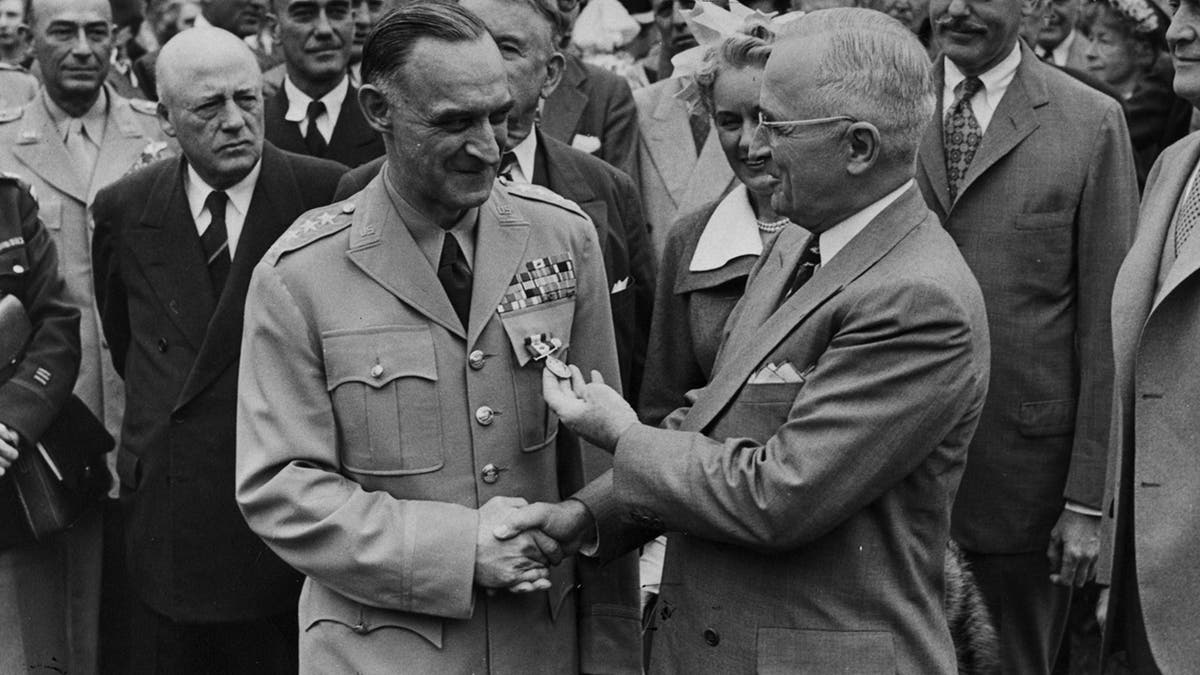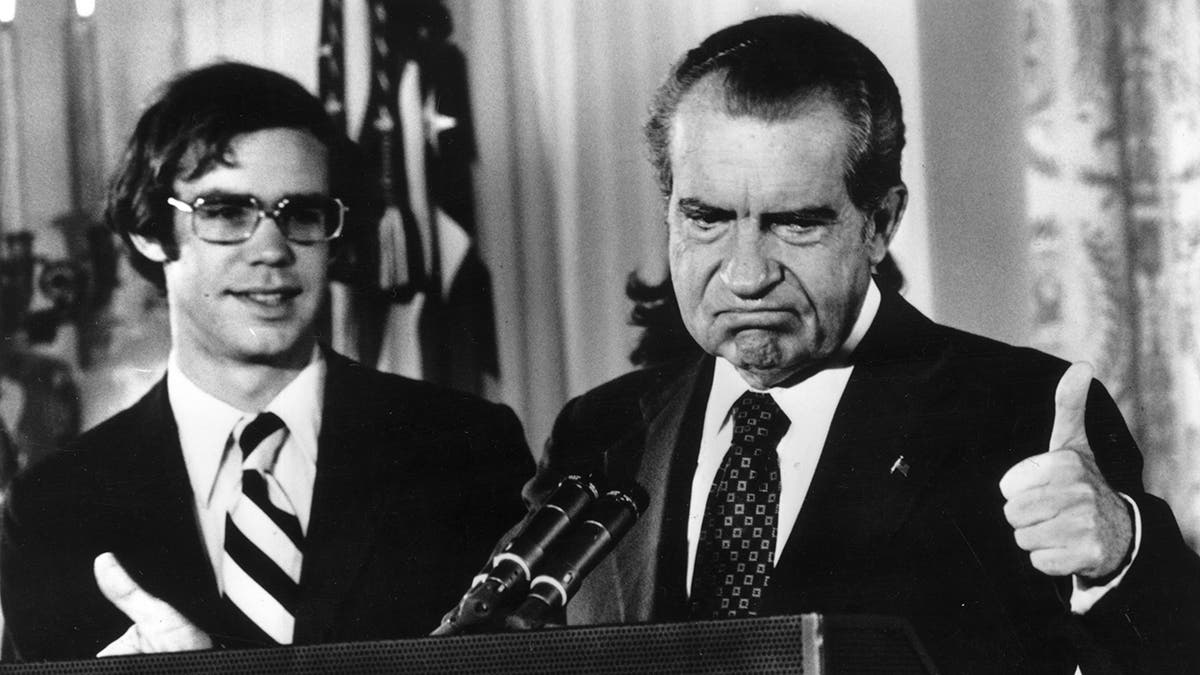First elected Dem to demand Biden withdraw asks: ‘Why take a chance when there is a better alternative?’
The first elected Democratic Party lawmaker to call for President Biden to ditch his re-election bid is insisting that there is no point in taking a risk on him running again when there is a "better alternative."
President Franklin D. Roosevelt (FDR) had just concluded breakfast on an early spring day on April 12, 1945, at his "Little White House" atop Pine Mountain in Warm Springs, Georgia.
He was one month into his 12th year of the presidency.
The president had recently returned from the Big Three Conference in Yalta, Crimea, where, with British Prime Minister Winston Churchill and Russian leader Joseph Stalin, he discussed the future of Eastern Europe, the role of the Soviet Union in the Pacific war against Japan and a new post-war organization called the United Nations.
KJP: THE PRESIDENT IS 'CLEAR-EYED AND STAYING IN THE RACE'
The president was resting after a grueling schedule while his mind as commander in chief was with the soldiers, Marines and naval forces of the United States fighting in two theaters as the U.S. WWII campaign entered its fourth year.

President Franklin D. Roosevelt talks to the nation in a fireside chat from the White House in this November 1937 photo.
On his schedule this day in Warm Springs, Georgia, was some time sitting for some sketches that would inform his presidential portrait.
Shortly before 1:00 p.m., as the painting began, the president uttered "I have a terrific headache," ushering in the final moments of his life in the 64th year.
The president was pronounced dead at 3:35 p.m. of a cerebral hemorrhage.
The news of FDR’s death was quietly communicated to the White House in Washington and the wheels were put in motion to locate FDR’s new vice president, Harry S. Truman.
At the time of Truman’s selection as vice presidential-candidate in 1944, FDR had encouraged and supported the judgment of the Democratic convention delegates in Chicago to place Truman on the ticket, citing his experience as the wartime Arms Review Board chairman in the Senate and as a no-nonsense leader that loyally supported Roosevelt since his election to the Senate in 1940.
The Chicago convention delegates didn’t have a 25th Amendment to lean on.
The delegates were relying on the boss system of politics to design a deal to dump incumbent Vice President Henry A. Wallace in favor of a "Missouri Compromise" and "Common Denominator" candidate who wouldn’t hurt FDR’s 1944 electability for an historic fourth term.
The convention bosses colluded with FDR to affirm Truman’s acceptability and then used a series of ballot tactics, smoke-filled room meetings on the top floors of Chicago hotels and well-timed delegate rallies on the convention floor that resulted in a reluctant Harry S. Truman winning the nomination on July 21, 1944.

President Harry S. Truman (1884-1972) awarded American General Lucius Clay (1897-1978) with the Distinguished Service Medal for his role in the Berlin Airlift. (Photo by MPI/Getty Images)
The 25th Amendment to the Constitution was proposed by Congress and ratified by the states after President John F. Kennedy was assassinated on Nov. 22, 1963.
The amendment provides important procedures for replacing the president or vice president in the event of death, removal, resignation or incapacitation.
The amendment has been used once in the mid-1970s first when Gerald R. Ford replaced Spiro Agnew as vice president, then when Ford replaced Richard Nixon as president. Nelson Rockefeller then filled the resulting vice presidential vacancy when Ford assumed the presidency.
With a world not unlike that of 1945 with Axis powers, warfare and an unknown future in mind — it is useful to recall FDR’s 1944 convention and campaign with his new vice-presidential candidate, and the good fortune of the nation and allies to have Truman in place upon FDR’s tragic death at Warm Springs.
He was there not as a result of law, but as a result of decision-making at the convention based on the good of the nation as well as the party.
With the recent confirmation of President Biden and former President Trump securing their party’s respective nominations, the delegates have a chance to consider the elements of the 25th Amendment when nominating and voting on a vice president for the 2024 presidential campaign.
What’s In the XXV (25th) Amendment?
There are four sections within the 25th Amendment to the Constitution and each important to consider when selecting a president of vice president during 2024’s surging political crisis in the wake of Biden’s alarming presidential debate performance.
Section 1 is used in case of the removal of the president from office is warranted due to the president’s death or resignation. In this case, the vice president shall become president.

Richard Nixon gives the thumbs up after his resignation as 37th president of the United States. (Gene Forte/Consolidated News Pictures/Getty Images)
Section 2 is used whenever there is a vacancy in the office of the vice president requiring the president to nominate a new vice president who, after a majority vote of both Houses of Congress, will be able to take office.
Section 3 has been used during presidential surgeries where the powers and duties of the president are discharged by the vice president as acting president. The first time we had an "Acting President" under this section is when President Ronald Reagan sent a letter to Congress announcing that Vice President George H.W. Bush would serve as "Acting President" during the time of his July 1985 surgery at Bethesda Naval Hospital.
CLICK HERE FOR MORE FOX NEWS OPINION
The final section, Section 4, is the judgment section that compels the vice president and a majority of either the principal officers of the executive departments to transmit to the president pro tempore of the Senate and the speaker of the House of Representatives their written declaration that the president is unable to discharge the powers and duties of the office.
Once this is done the vice president assumes the powers and duties of the office as "Acting President."
With a world not unlike that of 1945 with Axis powers, warfare and an unknown future in mind — it is useful to recall FDR’s 1944 convention and campaign with his new vice-presidential candidate, and the good fortune of the nation and allies to have Truman in place upon FDR’s tragic death at Warm Springs.
Will we be talking about 25 in 25?
It is likely we will be mindful of the 25th Amendment in 2025, however, a better time to be thinking through the elements of the amendment should now in advance of the 2024 national conventions in Chicago and Milwaukee.
With the external and internal economic and security challenges the nation faces, the political candidates themselves and the policy power brokers should listen intently to the concerns of the American people who remain risk adverse to shocks within the U.S. government related to President Joe Biden’s health or and another gray swan event like COVID-19 or a strengthened Axis of Resistance challenge to world order by Russia, China, Iran, North Korea or a terrorist incident inside the US homeland.
CLICK HERE TO GET THE FOX NEWS APP
With the historical performance of President Harry S. Truman in mind, let’s be thoughtful in selecting the right vice president using the 25th Amendment as a guide.
Let’s really think about presidential succession and do it right before the president is no longer able to serve or a significant Gray Swan event emerges at the president’s doorstep.



